Does Aluminum Foil Affect Air Fryer Performance?
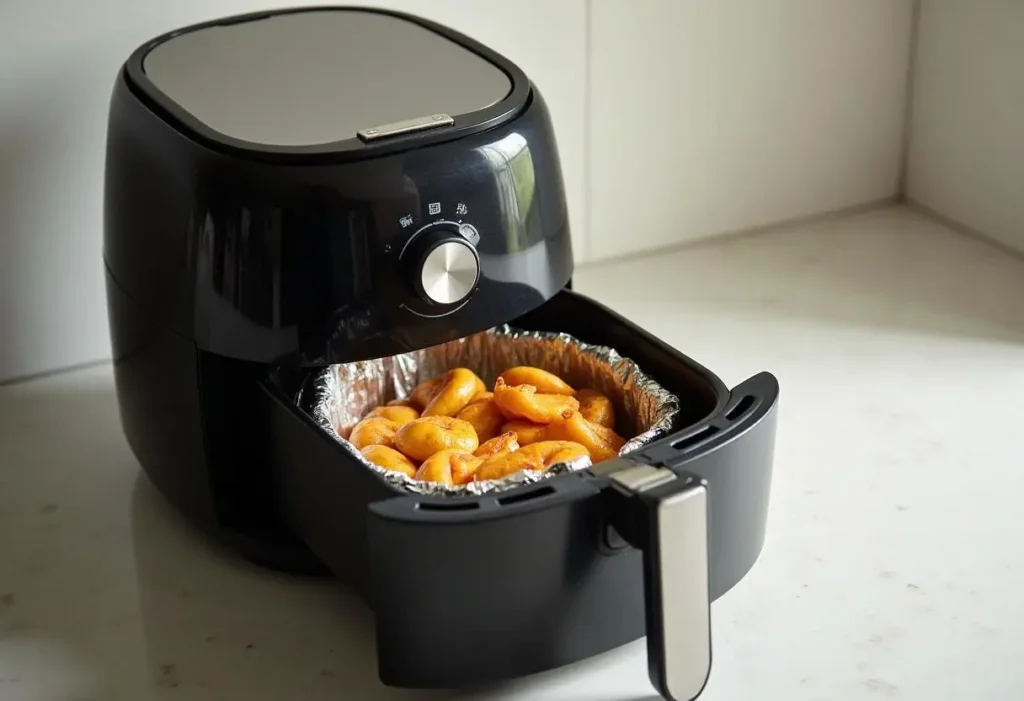
Air fryers have become a must-have kitchen appliance, known for their ability to deliver crispy, delicious meals with minimal oil. However, many home cooks wonder, “Does aluminum foil affect air fryer cooking?” This question arises because while aluminum foil is a versatile and convenient kitchen tool, its use in an air fryer requires careful consideration to ensure safety and maintain the appliance’s performance. In this article, we’ll explore the effects of aluminum foil on air fryer functionality, safety, and cooking results, providing clear guidance on when and how to use it effectively.
The Basics of Aluminum Foil and Air Fryers
What Is Aluminum Foil?
Aluminum foil is a thin, reflective sheet of aluminum widely used in cooking for its versatility and excellent heat conduction. It’s a common tool in baking, grilling, and roasting because it helps retain moisture, distribute heat evenly, and simplify cleanup. However, its application in air fryers isn’t always straightforward due to the appliance’s reliance on airflow for cooking.
How Air Fryers Work
Air fryers cook food by circulating hot air around it at high speeds, mimicking the effect of frying. This technology, often called Rapid Air Technology, relies on proper airflow to cook food evenly, achieving a crispy exterior and moist interior. Any obstruction to this airflow can hinder performance, which is why using aluminum foil in an air fryer requires caution and strategic placement.
Can You Use Aluminum Foil in an Air Fryer?
The short answer is yes, but with several caveats. Aluminum foil can be used in an air fryer, but it must Many air fryer users ask, “Does aluminum foil affect air fryer cooking?” The good news is that aluminum foil can be safely used in an air fryer if proper guidelines are followed. The key to success lies in understanding how foil interacts with the air fryer’s unique cooking process. Here are some essential considerations:
- Proper Placement: Always place aluminum foil in the basket or on the tray. Avoid letting it touch the heating element, as this could pose a fire hazard.
- Allow for Airflow: Air fryers rely on rapid circulation of hot air to cook food evenly. If the foil blocks airflow, you might experience uneven cooking or longer cook times.
- Avoid Overuse: Use foil only when necessary, such as for catching drippings or cooking foods with marinades. Overusing foil can interfere with the air fryer’s efficiency.
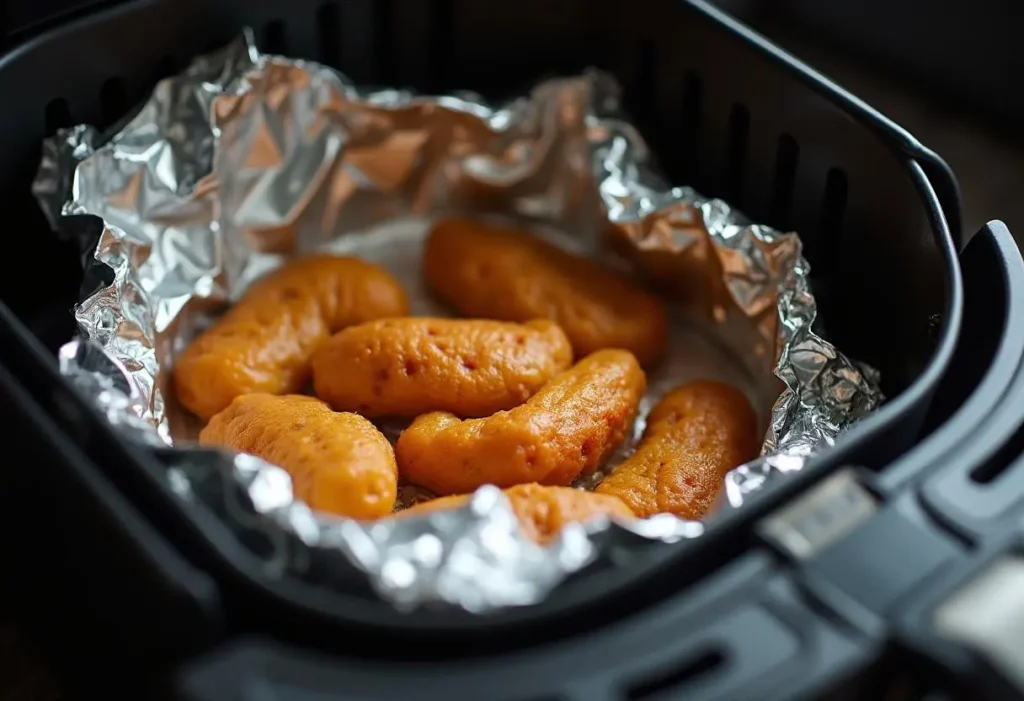
Using aluminum foil incorrectly can lead to safety risks and uneven results, but when done right, it can enhance your air fryer experience without negatively impacting its performance. Remember, the keyphrase “Does aluminum foil affect air fryer cooking?” is not just a question—it’s the foundation for
Pros and Cons of Using Aluminum Foil in Air Fryers
Advantages of Using Aluminum Foil
Using aluminum foil in an air fryer has several benefits:
- Simplifies Cleanup: Foil can catch grease and food particles, making cleanup faster and easier.
- Prevents Food Loss: Small or delicate items, such as chopped vegetables or thinly sliced meats, are less likely to fall through the basket.
- Enhances Certain Recipes: Foil can help retain moisture in foods like fish, chicken, or baked goods, improving texture and flavor.
Disadvantages to Consider
While aluminum foil can be helpful, it also has potential downsides:
- Obstructed Airflow: Improper placement of foil can block the hot air needed for cooking, resulting in uneven or undercooked food.
- Safety Risks: If foil touches the heating element, it can create a fire hazard.
- Reduced Crispiness: Foods that rely on full exposure to circulating air may lose their signature crispy texture when cooked with foil.
- Environmental Concerns: Foil is a single-use material that contributes to waste, making it less eco-friendly than reusable alternatives.
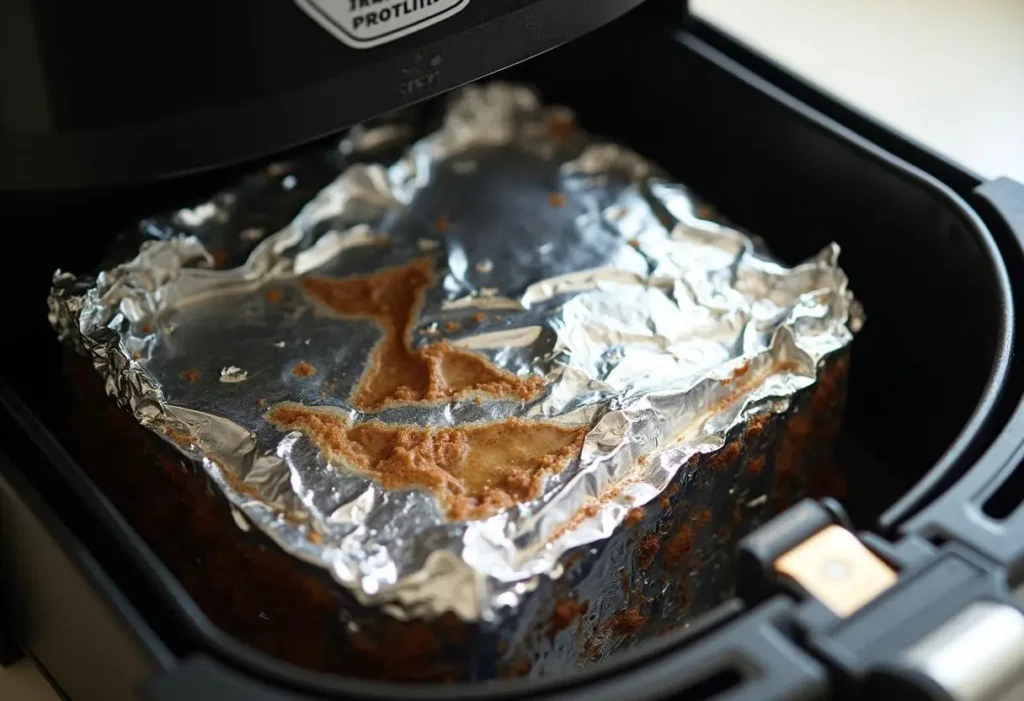
The Impact of Aluminum Foil on Cooking Results
How Aluminum Foil Affects Air Circulation
Air fryers are designed to cook food using rapid and unrestricted airflow. When foil covers too much of the basket or tray, it disrupts this circulation, leading to:
- Uneven Cooking: Hot air may not reach all areas of the food, leaving some parts undercooked.
- Longer Cooking Times: Obstructed airflow can slow down the cooking process.
- Reduced Crispiness: Foods that depend on high airflow for a crispy texture, like fries or chicken wings, may turn out softer when cooked with foil.
Health and Safety Considerations
When using aluminum foil in an air fryer, it’s important to keep the following in mind:
- Avoid Highly Acidic Foods: Foods like tomatoes, citrus, and vinegar-based dishes can react with aluminum, causing it to leach into your food. While the health risks are minimal, they’re worth considering.
- Proper Handling: Use food-grade foil and handle it carefully to avoid tearing, which can lead to messes and safety risks.
By addressing these factors, you can use foil in your air fryer without compromising safety or food quality.
Best Practices for Using Aluminum Foil in an Air Fryer
If you choose to use aluminum foil in your air fryer, follow these best practices to ensure safety and optimal results:
- Secure the Foil: Use food or weights to hold the foil in place. Loose foil can fly around inside the fryer, potentially touching the heating element.
- Leave Space for Airflow: Avoid covering the entire basket or tray. Leave gaps for air to circulate freely.
- Use Foil Sparingly: Reserve foil for foods that truly benefit from it, such as greasy or sticky dishes.
Foods Suitable for Aluminum Foil
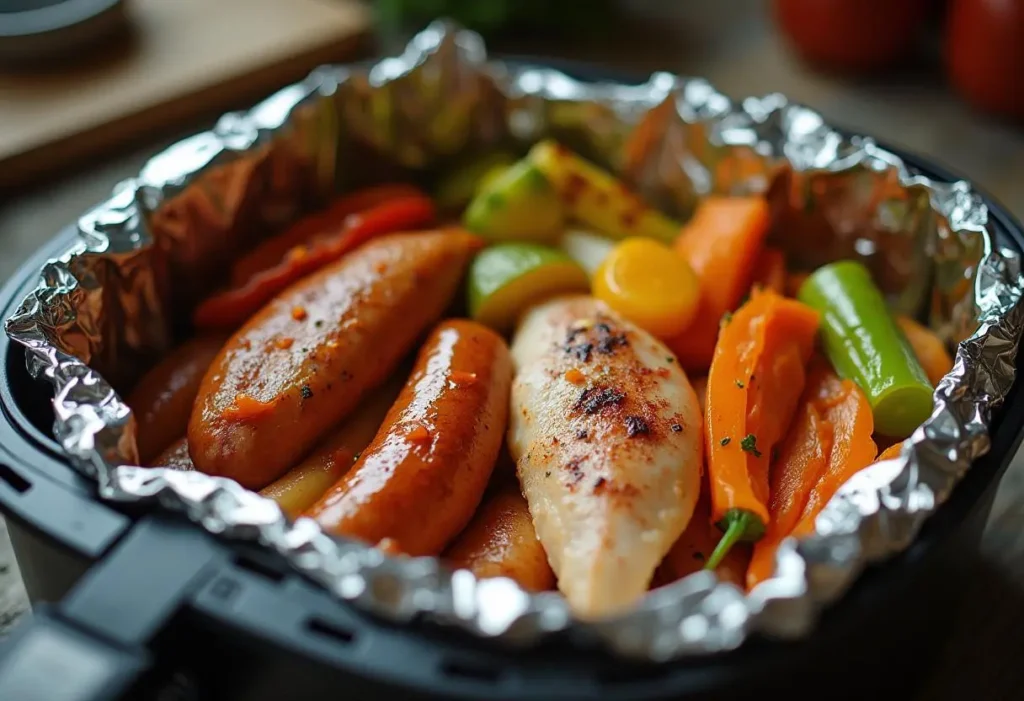
Certain foods are well-suited for cooking with foil in an air fryer:
- Meats with Marinades: Foil can help contain marinades and prevent dripping.
- Delicate Foods: Items like flaky fish or stuffed mushrooms benefit from the moisture retention provided by foil.
- Sticky or Greasy Dishes: Foods like barbecue chicken or glazed vegetables can be cooked more cleanly with foil.
- Chicken Sausage and Similar Foods: When cooking chicken sausage, foil can be used to prevent sticking and simplify cleanup. For an easy and delicious recipe, check out How to Cook Air Fryer Chicken Sausage.
Alternatives to Aluminum Foil
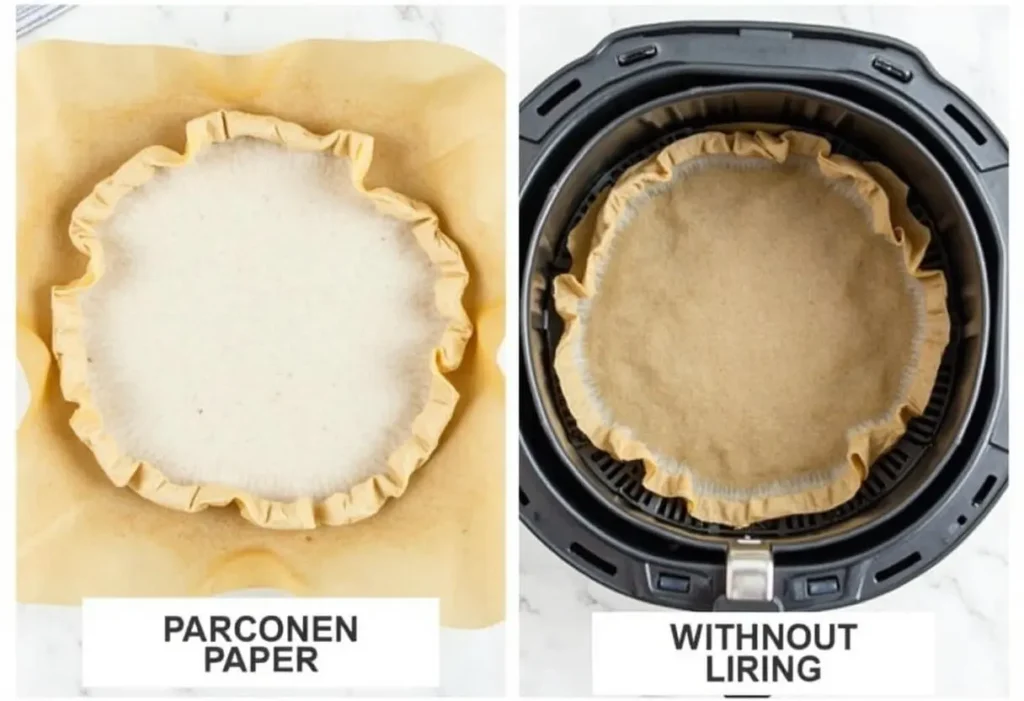
If you’re concerned about the downsides of using aluminum foil, there are alternatives that offer similar benefits without the risks:
- Parchment Paper: A heat-resistant, non-stick option that’s safe for air fryers and doesn’t obstruct airflow.
- Silicone Liners: Reusable and eco-friendly, these liners are specifically designed for air fryers and offer easy cleanup.
- Direct Basket Use: Many foods can be cooked directly in the basket without any lining, preserving their crispiness and flavor.
These alternatives not only improve cooking results but also align with sustainable practices by reducing waste.
FAQ : Aluminum Foil and Air Fryers
1. Is it bad to put aluminum foil in the air fryer?
No, it is not necessarily bad to use aluminum foil in an air fryer, but you must be cautious. For example, ensure the foil does not block airflow or come into contact with the heating element, as this could lead to uneven cooking or even safety hazards. Therefore, proper placement is essential to maintain the air fryer’s efficiency and safety.
2. Is it better to use foil or parchment paper in an air fryer?
It depends on your cooking needs. On the one hand, parchment paper is excellent for preventing sticking and maintaining airflow. On the other hand, aluminum foil is more suitable for retaining moisture in foods like fish or for catching drippings from marinated meats. Thus, both options have their unique advantages, and choosing one over the other depends on the recipe you’re preparing.
3. What is the best thing to put on the bottom of an air fryer?
For the bottom of your air fryer, consider using a perforated parchment liner or a silicone mat. These options are ideal because they allow proper airflow while also catching food particles and grease. Consequently, cleanup becomes much easier, and the air fryer’s performance remains unaffected.
4. What can you not put in an air fryer?
There are several items you should avoid placing in an air fryer. For instance:
Wet-battered foods, such as tempura, may drip and fail to crisp properly.
Highly acidic foods like tomatoes should not be used with aluminum foil, as this can cause a chemical reaction.
Materials that are not air fryer-safe, such as plastic or wax paper, can melt or catch fire
Conclusion: Does Aluminum Foil Affect Air Fryer Performance?
Using aluminum foil in an air fryer is both safe and practical when done correctly. It can simplify cleanup, prevent food loss, and improve certain recipes. However, improper use can lead to safety risks, obstructed airflow, and reduced food quality. By adhering to best practices, such as ensuring proper placement and avoiding acidic foods, you can enjoy the benefits of foil while minimizing potential downsides.
For those seeking an alternative to aluminum foil, options like parchment paper and silicone liners provide similar advantages without the environmental impact. Ultimately, understanding the interaction between aluminum foil and air fryer mechanics is key to making informed cooking decisions.
Whether you use foil or not, the air fryer remains a versatile tool for preparing healthy, delicious meals with ease. Make the most of it by prioritizing safety, airflow, and food quality in every dish!







2 Comments